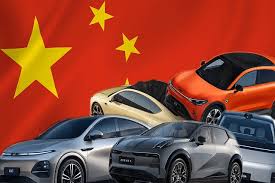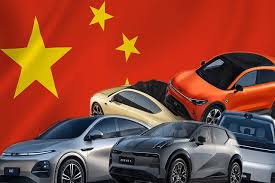
Late last month, the world’s largest car-carrying vessel—capable of bearing the equivalent of 20 football fields’ worth of automobiles—made its maiden call at Itajaí, Brazil’s bustling southern port. On board, some 5,500 battery-electric vehicles (BEVs) from China’s BYD, the world’s leading producer of green cars, disembarked to join an already swelling fleet of imports. While consumers have welcomed access to advanced, competitively priced EVs, Brazilian automakers, labor unions and government officials are sounding alarms over the rapid influx of low-cost Chinese models. Their concern: domestic industry and employment could be sidelined by an aggressive export strategy rooted in undercutting global competition.
Over the past five years, China’s automotive sector has witnessed a production surge that transformed the country into the world’s top exporter of new vehicles, overtaking Japan in 2023. Fueled by excess factory capacity and government incentives, Chinese manufacturers have embarked on an ambitious push into overseas markets, with Brazil emerging as a prime target. Brazil’s electric-vehicle market, still in its formative stage, offers a relatively open tariff environment and growing consumer interest in cleaner mobility—an ideal combination for cost-sensitive exporters seeking rapid volume gains.
Tapping Brazil’s Transitional Tariff Regime
When Brazil dismantled its EV tariffs in 2015 to jumpstart electric-car adoption, it inadvertently created an opening for foreign suppliers. Recognizing this advantage, Chinese firms moved swiftly: BYD has already dispatched four full-capacity car carriers to Brazil so far in 2025, unloading roughly 22,000 EVs. Under a policy allowing duty-free imports up to specified quotas—US$169 million for plug-in hybrids and US$226 million for BEVs through mid‑2025—Chinese brands front‑loaded shipments to maximize tariff exemptions. Even as Brazil reintroduced a modest 10% levy last year, scheduled to climb to 35% by 2026, many analysts expect Chinese exporters to accelerate deliveries ahead of each tariff increase.
China’s factories are churning out more EVs than domestic demand can absorb, a surplus partly driven by Beijing’s subsidies for green vehicles. With local markets maturing and price wars intensifying—BYD famously slashed its entry‑level Seagull hatchback to under US$10,000—producers have pivoted to exports. Europe and Southeast Asia have imposed hefty duties on Chinese cars: up to 45% in the European Union and more than 100% in the United States, alongside software restrictions. Latin America, by contrast, presents fewer trade barriers and a substantial consumer base, making Brazil especially attractive. Analysts estimate that EV imports into Brazil will rise nearly 40% this year, reaching some 200,000 units and representing about 8% of total light‑vehicle registrations.
Brazil’s long‑established automakers—including Volkswagen, General Motors and Stellantis—have built production networks in regions across the country for decades. Now, they face competition they did not fully anticipate. Auto‑industry group ANFAVEA and union confederation IndustriALL Brasil have petitioned the federal government to accelerate planned tariff hikes—from the current 10% to 35%—by at least a year. “Countries around the world started closing their doors to the Chinese, but Brazil didn’t,” declared Aroaldo da Silva, a Mercedes‑Benz production worker and union leader. He argues that without prompt tariff adjustments, domestic manufacturing and supplier development will falter.
Investment Promises Versus Reality
Several Chinese automakers have publicly pledged to invest in Brazilian production facilities, lured by government incentives and local resource availability. In 2023, BYD announced plans to acquire a former Ford factory in Bahia state—a move expected to generate thousands of jobs and localize supply chains. Yet progress has lagged: labor‑rights probes at the construction site delayed “fully functional” plant operations until late 2026. Similarly, Great Wall Motors (GWM) postponed its launch of Brazil‑built Haval SUVs by more than a year due to logistical setbacks. Critics fear import volumes will continue to balloon absent concrete factory investments and robust supplier partnerships.
Brazil’s Ministry of Development, Industry & Foreign Trade has acknowledged industry concerns and is reviewing requests to expedite the EV‑tariff schedule. “The gradual resumption of tariffs, with decreasing quotas, was designed to align with companies’ development plans and the maturity of local manufacturing,” a ministry spokesperson said. Officials emphasize the need to balance consumer access to affordable clean vehicles against the imperative of nurturing domestic industry. Meanwhile, President Lula da Silva’s administration faces the dual challenge of bolstering Brazil’s industrial revival and maintaining its environmental commitments ahead of hosting the COP30 climate summit in November.
Local Content and Supply Chain Development
Although Brazil boasts abundant mineral reserves—lithium, nickel and cobalt essential for battery production—the country lacks a comprehensive domestic battery and component industry. GWM’s Brazilian arm reports discussions with over 100 local suppliers to source parts for its planned 50,000‑unit‑per‑year factory, yet few formal contracts have materialized. IndustriALL’s da Silva notes the absence of signed agreements typical of pre‑production stages, questioning the true value added by foreign‑led assembly plants if key inputs remain imported.
Despite industry friction, Brazilian consumers are increasingly drawn to China’s affordable EV offerings. According to the Brazilian Electric Vehicle Association (ABVE), Chinese brands account for more than 80% of EV registrations nationwide. Urban buyers in São Paulo and Rio de Janeiro cite lower purchase prices, extended warranties and the convenience of home‑charging solutions as primary attractions. As infrastructure for public charging stations expands—fueled by incentives and private investment—the cost differential between imported Chinese models and domestically built alternatives will likely remain a decisive factor for cost‑conscious motorists.
Brazil’s auto sector stands at a critical crossroads. Policymakers must decide whether to lean into imported EVs to meet climate targets affordably or to fortify local manufacturing capacity to safeguard jobs and technology transfer. Accelerated tariff increases could temper import growth but risk slowing the adoption of cleaner vehicles. Conversely, continued tariff restraint may undermine Brazil’s industrial ambitions. For Chinese manufacturers, the calculus centers on leveraging Brazil’s transitional policies to cement market share and export volume, all while addressing—or deferring—their onshore manufacturing commitments.
As the global electric‑vehicle revolution accelerates, Brazil’s response to China’s strategic incursion will shape the country’s industrial landscape for years to come. The choices made today—in tariffs, investments and supply‑chain development—will determine whether Brazil remains a gateway for cheap imports or evolves into a thriving hub for green‑vehicle innovation.
(Source:www.marketscreener.com)
Over the past five years, China’s automotive sector has witnessed a production surge that transformed the country into the world’s top exporter of new vehicles, overtaking Japan in 2023. Fueled by excess factory capacity and government incentives, Chinese manufacturers have embarked on an ambitious push into overseas markets, with Brazil emerging as a prime target. Brazil’s electric-vehicle market, still in its formative stage, offers a relatively open tariff environment and growing consumer interest in cleaner mobility—an ideal combination for cost-sensitive exporters seeking rapid volume gains.
Tapping Brazil’s Transitional Tariff Regime
When Brazil dismantled its EV tariffs in 2015 to jumpstart electric-car adoption, it inadvertently created an opening for foreign suppliers. Recognizing this advantage, Chinese firms moved swiftly: BYD has already dispatched four full-capacity car carriers to Brazil so far in 2025, unloading roughly 22,000 EVs. Under a policy allowing duty-free imports up to specified quotas—US$169 million for plug-in hybrids and US$226 million for BEVs through mid‑2025—Chinese brands front‑loaded shipments to maximize tariff exemptions. Even as Brazil reintroduced a modest 10% levy last year, scheduled to climb to 35% by 2026, many analysts expect Chinese exporters to accelerate deliveries ahead of each tariff increase.
China’s factories are churning out more EVs than domestic demand can absorb, a surplus partly driven by Beijing’s subsidies for green vehicles. With local markets maturing and price wars intensifying—BYD famously slashed its entry‑level Seagull hatchback to under US$10,000—producers have pivoted to exports. Europe and Southeast Asia have imposed hefty duties on Chinese cars: up to 45% in the European Union and more than 100% in the United States, alongside software restrictions. Latin America, by contrast, presents fewer trade barriers and a substantial consumer base, making Brazil especially attractive. Analysts estimate that EV imports into Brazil will rise nearly 40% this year, reaching some 200,000 units and representing about 8% of total light‑vehicle registrations.
Brazil’s long‑established automakers—including Volkswagen, General Motors and Stellantis—have built production networks in regions across the country for decades. Now, they face competition they did not fully anticipate. Auto‑industry group ANFAVEA and union confederation IndustriALL Brasil have petitioned the federal government to accelerate planned tariff hikes—from the current 10% to 35%—by at least a year. “Countries around the world started closing their doors to the Chinese, but Brazil didn’t,” declared Aroaldo da Silva, a Mercedes‑Benz production worker and union leader. He argues that without prompt tariff adjustments, domestic manufacturing and supplier development will falter.
Investment Promises Versus Reality
Several Chinese automakers have publicly pledged to invest in Brazilian production facilities, lured by government incentives and local resource availability. In 2023, BYD announced plans to acquire a former Ford factory in Bahia state—a move expected to generate thousands of jobs and localize supply chains. Yet progress has lagged: labor‑rights probes at the construction site delayed “fully functional” plant operations until late 2026. Similarly, Great Wall Motors (GWM) postponed its launch of Brazil‑built Haval SUVs by more than a year due to logistical setbacks. Critics fear import volumes will continue to balloon absent concrete factory investments and robust supplier partnerships.
Brazil’s Ministry of Development, Industry & Foreign Trade has acknowledged industry concerns and is reviewing requests to expedite the EV‑tariff schedule. “The gradual resumption of tariffs, with decreasing quotas, was designed to align with companies’ development plans and the maturity of local manufacturing,” a ministry spokesperson said. Officials emphasize the need to balance consumer access to affordable clean vehicles against the imperative of nurturing domestic industry. Meanwhile, President Lula da Silva’s administration faces the dual challenge of bolstering Brazil’s industrial revival and maintaining its environmental commitments ahead of hosting the COP30 climate summit in November.
Local Content and Supply Chain Development
Although Brazil boasts abundant mineral reserves—lithium, nickel and cobalt essential for battery production—the country lacks a comprehensive domestic battery and component industry. GWM’s Brazilian arm reports discussions with over 100 local suppliers to source parts for its planned 50,000‑unit‑per‑year factory, yet few formal contracts have materialized. IndustriALL’s da Silva notes the absence of signed agreements typical of pre‑production stages, questioning the true value added by foreign‑led assembly plants if key inputs remain imported.
Despite industry friction, Brazilian consumers are increasingly drawn to China’s affordable EV offerings. According to the Brazilian Electric Vehicle Association (ABVE), Chinese brands account for more than 80% of EV registrations nationwide. Urban buyers in São Paulo and Rio de Janeiro cite lower purchase prices, extended warranties and the convenience of home‑charging solutions as primary attractions. As infrastructure for public charging stations expands—fueled by incentives and private investment—the cost differential between imported Chinese models and domestically built alternatives will likely remain a decisive factor for cost‑conscious motorists.
Brazil’s auto sector stands at a critical crossroads. Policymakers must decide whether to lean into imported EVs to meet climate targets affordably or to fortify local manufacturing capacity to safeguard jobs and technology transfer. Accelerated tariff increases could temper import growth but risk slowing the adoption of cleaner vehicles. Conversely, continued tariff restraint may undermine Brazil’s industrial ambitions. For Chinese manufacturers, the calculus centers on leveraging Brazil’s transitional policies to cement market share and export volume, all while addressing—or deferring—their onshore manufacturing commitments.
As the global electric‑vehicle revolution accelerates, Brazil’s response to China’s strategic incursion will shape the country’s industrial landscape for years to come. The choices made today—in tariffs, investments and supply‑chain development—will determine whether Brazil remains a gateway for cheap imports or evolves into a thriving hub for green‑vehicle innovation.
(Source:www.marketscreener.com)














